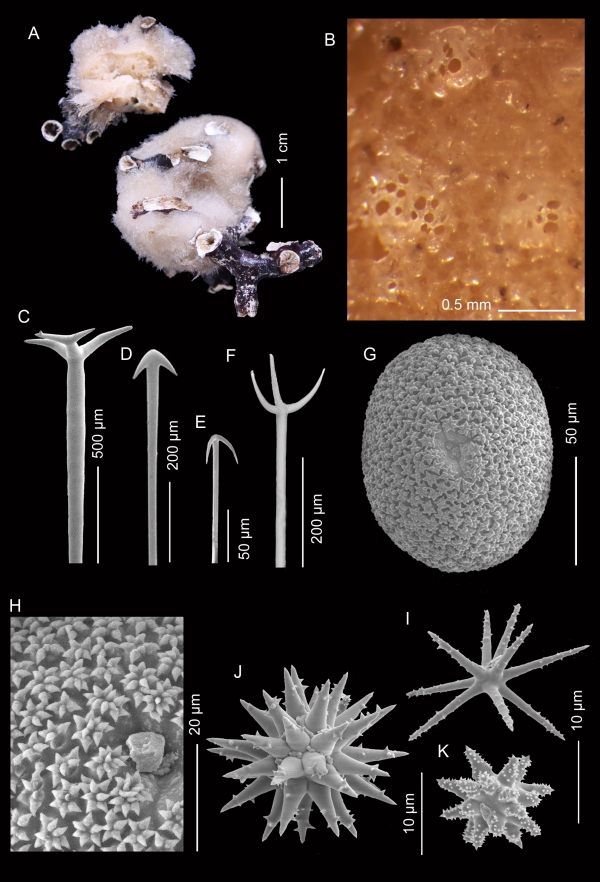Geodia ewok Sim-Smith & Kelly, 2015 is an astrophorid sponge from the family Geodiidae. It was described, along with 16 other new species, in a recent publication by Sim-Smith & Kelly (2015) (see our previous Facebook post about the release of the Geodiidae memoir here), which increased the number of described New Zealand Geodiidae fauna from four to 22!
Geodiidae sponges generally have a thick, tough, leathery crust or shell, and are most commonly cream, yellow, brown or black in life. They can be encrusting on other substrates or can be globular spheres. Geodia ewok is of the encrusting type and is generally found attached to coral branches, between 680–1280 m deep, on the Chatham Rise, Hikurangi Margin and Louisville Seamounts. It is small, rounded and very bristly, and it was these characteristics that gave rise to its name ‘ewok’. The species etymology reads “Named for the resemblance of this species to an ewok, a fictional race of small, mammaloid bipeds that appear in the Star Wars universe”.
Spiky spicules
Don’t be deceived by its fluffy looking appearance though because astrophorid demosponges, including Geodia ewok, can be very prickly - with sharp, spiky, and remarkable looking structures appearing under very high magnification. The spiky structures in the image of the species are their small thin spicules, or ‘skeleton’, which are made up of fibers of the organic protein spongin, or the mineral opaline (hydrated silica), or both.
Geodiidae sponges worldwide
Family Geodiidae comprises more than 260 species which are distributed widely, both geographically and bathymetrically. These sponges can even be the dominant fauna on the outer continental shelf and upper-slope regions on hard bottom habitat, particularly in the Northern Hemisphere. In some of these areas it has been found that the associated fauna is rich and varied, making them ecologically important. It’s even suggested that if these areas are left undisturbed from fishing activity, they might act as sanctuaries for fish and their prey and therefore replenish nearby trawling grounds (Klitgaard & Tendal, 2004).
References:
Sim-Smith, C., Kelly, M. (2015) The Marine Fauna of New Zealand: Sponges in the family Geodiidae (Demospongiae: Astrophorina). NIWA Biodiversity Memoir 128. 102 p.
Klitgaard, A. B., Tendal, O. S. (2004) Distribution and species composition of mass occurrences of large-sized sponges in the northeast Atlantic. Progress in Oceanography 61: 57–9. http://www.sciencedirect.com/science/article/pii/S0079661104000680
Kelly, M., Edwards, K.R., Wilkinson, M. R., Alvarez, B., Cook, S., Bergquist, P. R., Buckeridge, J. S., Campbell, H. J., Reiswig, H. M., Valentine, C., Vacelet, J. (2009) Chapter One, Phylum Porifera, sponges. In: Gordon, D. P. (Ed). New Zealand Inventory of Biodiversity, Volume One, Kingdom Animalia Radiata, Lophotrochoza, Deuterostomia. Canterbury University Press, Canterbury: 23-46

